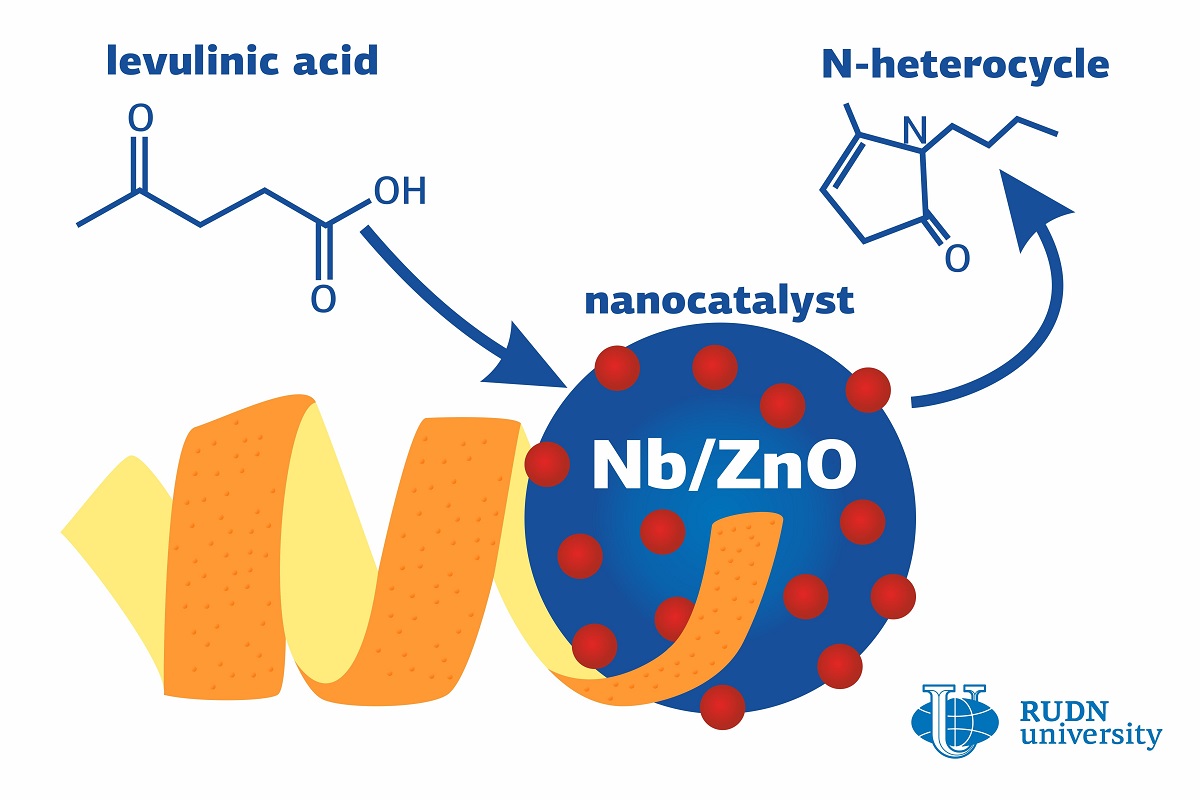RUDN University chemist created a catalyst from orange peel for organic compounds production

N-heterocycles are used in the production of plastics and medicinal drugs (quinine, morphine, pyramidon) and as dyes. Their synthesis requires the use of catalysts based on expensive noble metals such as gold, palladium, or iridium. All previous attempts to use other elements had been unsuccessful due to low efficiency or instability of the end products. However, a chemist from RUDN University developed a nanocatalyst based on cheaper metals—niobium and zinc. The new catalyst provides for almost 100% efficiency of N-heterocycle synthesis, and its precursor (or platform molecule) is levulinic acid.
“Levulinic acid is one of the top-10 most promising platform molecules that can be easily obtained from biomass. The transformation of levulinic acid into N-heterocycles has recently become a popular topic because N-heterocycles proved to be useful in the pharmaceutical, agrochemical, and polymer industries”, said Rafael Luque, PhD, the head of the Molecular Design and Synthesis of Innovative Compounds for Medicine Science Center at RUDN University.
His team used a mechanochemical method to create the nanocatalyst: it means, its components were simply mixed in a special grinder without solvents or other additives. Orange peel served as a template for the catalyst preparation. Ground peel, dry zinc acetate, and 18 1-cm steel balls were put in the grinder and mixed at 350 revolutions per minute for 20 minutes. After that, the mixture was heated at 200? for two hours. As a result, zinc oxide nanoparticles were formed. Orange peel was used to give zinc acetate a surface to concentrate on, and also to help form intermediary compounds. The remains of the peel were partially removed from the mix in the course of heating. After that, zinc oxide nanoparticles were combined in the grinder with niobium-containing particles so that the concentration of the metal in the end product would reach 2.5% to 10%.
To test the new nanocatalyst, the chemists used it to transform levulinic acid into an N-heterocycle. The team selected the most efficient ratio of the catalyst: 10% of niobium to 90% of zinc oxide. In this case, almost all levulinic acid (94.5%) was turned into the end product without byproducts, and N-heterocycles accounted for 97.4% of the yield.
“This work shows that if we play with the catalyst structure, valuable compounds can be developed from biowaste. Using organic waste and eco-friendly methods, we can offer an alternative to the modern-day chemical industry that is extremely dependent on fossil fuels,” added Rafael Luque.
The results of the study were published in the Catalysis Today journal.
RUDN summarized the results of the scientific competition "Project Start: work of the science club ". Students of the Faculty of Physics, Mathematics and Natural Sciences have created a project for a managed queuing system using a neural network to redistribute resources between 5G segments. How to increase flexibility, make the network fast and inexpensive and reach more users — tell Gebrial Ibram Esam Zekri ("Fundamental Computer Science and Information Technology", Master's degree, II course) and Ksenia Leontieva ("Applied Mathematics and Computer Science", Master's degree, I course).
The National Demographic Report, 2023 Demographic Well-Being of Russian Regions (hereinafter - the National Demographic Report) was prepared by the scientific team of the Institute of Demographic Studies of the Federal Research Center of the Russian Academy of Sciences, the Vologda Scientific Center of the Russian Academy of Sciences, Peoples' Friendship University of Russia, the Center for Family and Demography of the Academy of Sciences of the Republic of Tatarstan, as well as with the participation of leading scientists from the Republic of Bashkortostan, Stavropol Krai, Volgograd, Ivanovo, Kaliningrad, Nizhny Novgorod, Sverdlovsk Oblasts and Khanty-Mansi Autonomous Okrug–Yugra.
RUDN summarized the results of the scientific competition "Project Start: work of the science club ". Students of the Faculty of Physics, Mathematics and Natural Sciences have created a project for a managed queuing system using a neural network to redistribute resources between 5G segments. How to increase flexibility, make the network fast and inexpensive and reach more users — tell Gebrial Ibram Esam Zekri ("Fundamental Computer Science and Information Technology", Master's degree, II course) and Ksenia Leontieva ("Applied Mathematics and Computer Science", Master's degree, I course).
What is your first association with the word “laboratory”? Flasks and beakers? Microscopes and centrifuges? Yes, many of us would answer the same way.
The National Demographic Report, 2023 Demographic Well-Being of Russian Regions (hereinafter - the National Demographic Report) was prepared by the scientific team of the Institute of Demographic Studies of the Federal Research Center of the Russian Academy of Sciences, the Vologda Scientific Center of the Russian Academy of Sciences, Peoples' Friendship University of Russia, the Center for Family and Demography of the Academy of Sciences of the Republic of Tatarstan, as well as with the participation of leading scientists from the Republic of Bashkortostan, Stavropol Krai, Volgograd, Ivanovo, Kaliningrad, Nizhny Novgorod, Sverdlovsk Oblasts and Khanty-Mansi Autonomous Okrug–Yugra.